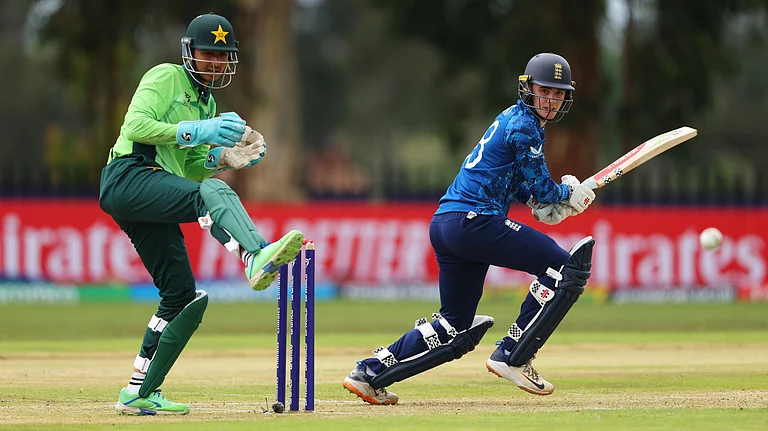Stories of miracles in the high Himalayan mountains are few and far between. But this spring climbing season in Nepal saw the miraculous rescue of an amateur Indian climber, Anurag Maloo, from Mt. Annapurna (8091m/26,546ft), the 10th highest mountain in the world. Annapurna’s reputation as one of the most challenging peaks to climb is well-earned, and its high death rate reflects this.
Others haven't been so lucky. There have been at least eleven deaths on Everest this season, and a few are untraceable. At the time of writing, an Indian-origin Singaporean climber, Shrinivas Sainis Datta, is missing.
Maloo’s rescue from 6000m on Annapurna by two Polish climbers and seven Sherpas will be remembered as one of the riskiest rescue operations on an 8000-er, as 8000m-plus peaks are known. The climbers risked their own lives and sacrificed their summit bids to bring Maloo back alive. Maloo is currently under treatment in New Delhi.
Maloo was attempting Annapurna, his very first 8000er, without supplementary oxygen. This tragic accident could perhaps have been averted if Maloo had more experience climbing higher mountains. Prior to attempting Annapurna, Maloo had only summited Ama Dablam (6812m) in 2022. Maloo’s plan was to climb two more 8000m peaks (Everest and Lhotse) this season.
In the past two decades, with the commercialization of mountaineering, the world has witnessed stupendous tragedies. There has been a marked increase in the number of Indians rushing to climb 8000m peaks, and lately, it is also about climbing without supplementary oxygen
Why this rush to climb 8000m peaks? What is pushing young Indian climbers into this race to outdo one another?
Guneet Puri, a professional mountain guide who believes in climbing the more difficult peaks in India, says, “I feel this race of climbing 8000ers year after year also stems from our mountaineering institutions. Some aspiring mountaineers have no concept of the history or ethos of mountaineering. The moment an individual has completed their basic and advanced courses, they want to start climbing 8000ers. There are all sorts of bizarre records being established. The thought is that if you climb Everest successfully, you can start giving inspirational talks and get paid well,” she says.
Expeditions to 8000m peaks in the 1960s and through the 1980s were largely sponsored by national institutions and large private organisations. Serious Indian mountaineers with a deep love for the sport climbed these mountains for the country. Since the 1990s, it has become more individual-led. Climbing 8000ers is now more of a personal achievement.
In the last decade or so, the increased commercialization of 8000m peaks has made these peaks more accessible. According to the book ‘The Himalaya by the Numbers’ by Elizabeth Hawley, the compound annual growth rate of climbing activity from 1990 to 2019 for all peaks in Nepal, including 8000m peaks, is 2.4%.
Despite most of these peaks having several routes, it’s the standard routes that have become popular. Conquering the high mountains via standard routes is no longer seen as an extreme type of climbing, but as a form of trekking at high altitudes, or what some serious climbers call "high altitude tourism”.
As alpinist Karn Kowshik, a professional mountain guide and ice climber, says, “All these 8000m peaks are aided climbs. The sherpas do all the work of fixing ropes, and all that the individual climber has to do is follow the rope. Such climbers are client climbers, not independent climbers. For modern alpinists or independent climbers, the route is more important than the summit itself.”
“The fact is that these climbers would not be able to even be there if it was not for the Nepali guides and Sherpas. These climbers really need to question whether they should be on the mountain at all,” Kowshik adds.
To climb an 8000m peak, one needs to have immense endurance and lots of experience. Lack of either amounts to disaster. The consequence of being an inexperienced climber is that the individual is totally reliant on the Sherpa for everything. The fallout is also that in the case of a disaster or body going weak, not only are some of them unable to manage on their own but also sometimes hold up others or put others’ lives at risk.
Climate change is another factor that is affecting climbing in general. Glaciers are receding at a faster pace, climbing seasons are seeing drastic weather changes leading to avalanches and disasters, and summit windows have become shorter. Climate change can be felt more acutely in the Himalayas, and it is making climbing more difficult. Hence, experience matters even more.
Arjun Vajpai, a well-known climber from India who has been attempting 8000er peaks since he was 16, and who, too, was recently rescued on Annapurna, says, “Individuals today climb these peaks in the hope of getting sponsorship for their future climbs.”
The summit opus craze also emanates from the fact that many climbers take huge loans. An Everest attempt costs Rs 30 lakh or more, approximately. So they are reluctant to let go of the summit and push themselves even when their bodies give up.
Parth Upadhyay from Mumbai, among the younger climbers to climb Everest from the North side, is so fed up of the 8000m obsession in the community that he is taking a break from 8000-ers.
“These climbs have become a joke, and I do not want to be a joker in this game,” he says. “I am steering clear of 8000ers for now and concentrating on climbing in India. The problem is, all information on peaks is easily available on the net, and you can sit at home and study the mountain and think you can climb it and make decisions without actually understanding the mountain.”
Six hundred and fifty Indians attempted Everest in the past decade, and 350 were successful in their summit bids, which is a 53.8% success rate. Mathematically, 23.5% of deaths on Everest (8 of the 34) in the past decade were Indians. These statistics are even more alarming when we take into account that Everest was closed to climbers in 2014, 2015, and 2020 from the Nepal side and in 2015, 2020, 2021 and 2022 from the China side.
In conclusion, inexperienced Indian climbers attempting 8000m peaks for the lure of record-setting, money and social media glory are toying with a behemoth, which is a troubling trend. It is important to ensure that mountaineering ethics and the importance of experience are imparted within the climbing community.
Anusha Subramanian is an Independent Journalist and a Professional Mountain Guide. She is currently working towards building awareness around inclusion of persons with disability in the outdoors.





















